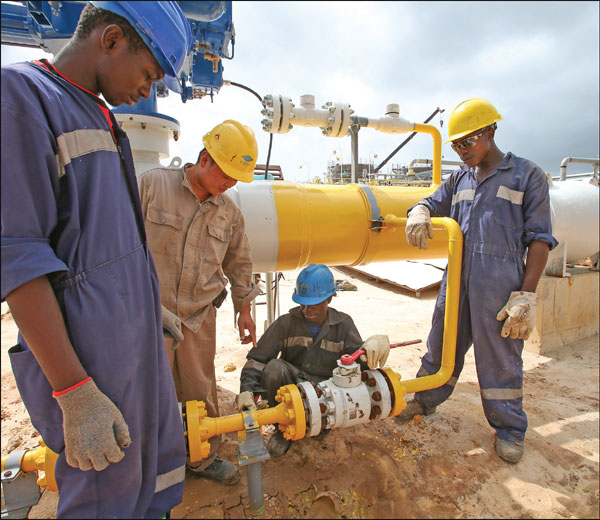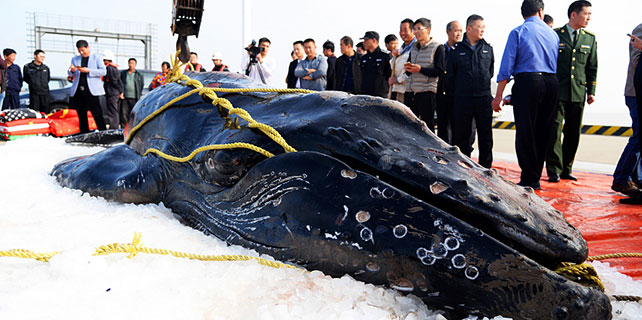Belt and Road investment beckons
Initiative opens up more potential opportunities for projects in Africa
A recently released report says countries in eastern Africa have the potential to become major destinations of Chinese outbound investment under the Belt and Road Initiative.
These countries, according to "Belt & Road: Opportunities & Risk - The prospects and perils of building China's New Silk Road", a report by Baker McKenzie and Silk Road Associates, are Kenya, Tanzania, Ethiopia, Djibouti and Egypt.
|
China Petroleum Technology and Development Corp, the builder of Tanzania's natural gas pipeline, has trained a large number of engineers, technicians and project managers. Zhang Ping / Xinhua |
The report says underdeveloped infrastructure such as energy and transportation will attract increased Chinese investment to the continent in the next five years. In addition, by 2025, benefits from Belt and Road will spread substantially to other sectors due to improved infrastructure, eventually attracting private players, especially in such nascent sectors as technology, telecommunications and manufacturing.
"East Africa is a more integral part of (Belt and Road) owing to Djibouti's ports, Ethiopia's manufacturing and the region's existing plans to connect rail, road and energy networks," says the report. Current investments range from standard gauge railways in Kenya and Ethiopia to planned projects in Tanzania and Uganda.
The World Bank estimates that the continent needs $93 billion per year to bridge its infrastructure gap. Moreover, a report by Ernst & Young says China is already the single largest contributor to foreign direct investment to the continent and has invested in 293 projects in Africa since 2005, totaling investment outlay of $66.4 billion.
The Baker McKenzie report says Egypt offers a significant opportunity for Chinese companies that will need to collaborate with local players and multilateral banks to surmount big challenges.
"Key opportunities will be transactions related to major projects in the power and infrastructure sector and related financing. China's construction of power plants and transmission lines in East Africa will be a game changer for local industry. Port connectivity will also improve significantly in the next five years," the report says.
It estimates that Belt and Road projects will see at least $350 billion in investment in new projects in countries participating in the initiative. While infrastructure development has been the primary Belt and Road driver, the Baker McKenzie report says other sectors will emerge to play a role.
There will be increased entry of Chinese smartphone and household electronic brands to Africa as they look to repeat their success in Southeast Asia and South Asia, the report says.
"Chinese investments in technology, media and telecommunications across the region, alongside rising incomes, will contribute to a surge in demand for smartphones and internet-based services. Moreover, China's leading private firms have the cash flow to fund their expansion into (Belt and Road) markets. They are not reliant on government funding and will leverage their distribution partners to grow."
Regarding consumer goods and retail, the report says China's investments in roads, railways and power across the continent will support household incomes and spur the already growing retail and food sectors.
Calling it a multidecade initiative that will reshape China's commercial engagement with the world, the report says that although Belt and Road will connect China and Europe, it "differs in that the Road passes through Southeast Asia, South Asia, the Middle East and East Africa, a region that is home to 42 percent of the world's population and 25 percent of its GDP, excluding China."
Stanley Jia, the chief Beijing representative of Baker McKenzie, says Belt and Road "is and will continue to be the most important and impactful macroeconomic undertaking in the world, for at least the next 10 years".
Noting that currently there are already more than 1,700 Belt and Road projects either completed or in development, Jia says that as more infrastructure projects are completed, more Chinese private companies will want to participate and will subsequently offer huge opportunities for local and international partners in a wide variety of sectors.
"Indeed, while (Belt and Road) was seen at its inception as predominantly the reserve of Chinese State-owned enterprises, funded by Chinese banks and staffed by Chinese workers, the sheer scale and ambition of the initiative means there will be plenty of opportunities for those local and multinational companies that can work hand in hand with Chinese organizations for mutual benefit, particularly as this second wave of Chinese investments arrives," Jia adds.
lucymorangi@chinadaily.com.cn

















